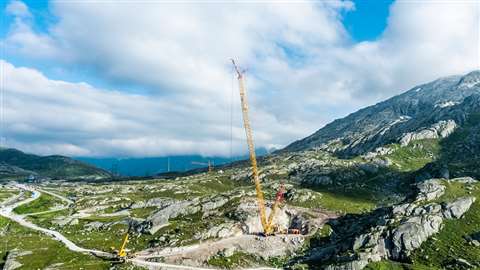Toggenburger at work on Swiss mountain
24 March 2022
Swiss specialist Toggenburger used a Tadano CC 3800-1 to erect an Enercon E 92 wind turbine on the Saint-Gotthard Massif mountain range in Switzerland.
 The site was a challenge due to a narrow access road, and parts of the crane had to be brougt to site seperately (Photo: Tadano)
The site was a challenge due to a narrow access road, and parts of the crane had to be brougt to site seperately (Photo: Tadano)
Challenges included narrow access roads, a sloping site and high altitudes of 2,000 metres. Not only was the work area tight, it was also about 20 metres lower than the foundation for the Enercon 92 wind turbine.
Since this was accompanied by the absence of a sufficiently large flat area, the 132 metre boom had to be installed downhill with a gradient of four degrees.
“Setting up a crawler crane in this kind of terrain really requires the use of specialists,” said Manuel Widmer, project manager of large-scale projects at Toggenburger.
Given these conditions, the company brought Tadano CC specialist Willi Friesen on board to get assistance from the manufacturer during the planning stage.
“The downhill slope on rough and uneven terrain, combined with the tight space conditions, meant that the boom and LF had to be put together while suspended in the air,” said Friesen.
Site specific
Tadano said the CC 3800-1 was somewhat oversized for the Enercon E 92 wind turbine, which was just under 100 metres tall, but was appropriate given the site conditions as there was a relatively large distance of 32 metres between the crane setup area and the wind turbine foundation, which would require working with a correspondingly large radius. Also, the setup area was located 18 metres below the tower foundation, meaning that this difference had to be added to the wind turbine’s actual height.
“Thanks to the CC 3800-1’s lifting capacity in an LH+LF3 configuration, even without the Superlift system, we were able to cost-effectively offer Enercon an additional crane for erecting towers at the wind farm,” said Widmer.
Due to a narrow access road, the winches and A-frame from the base crane had to be removed and brought up the mountain separately. All components parts had to be supplied in a just-in-time basis as there was little space on site, too.
“Getting the crane parts to the mountain really was a logistical challenge,” said Widmer.
The heaviest load was the nacelle which weighed 65 tonnes. The crane lifted all components with a 20 degree offset at a radius of 32 metres.
STAY CONNECTED


Receive the information you need when you need it through our world-leading magazines, newsletters and daily briefings.




